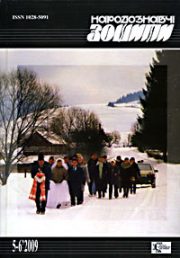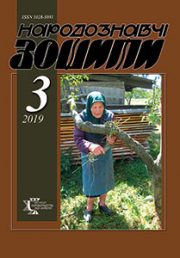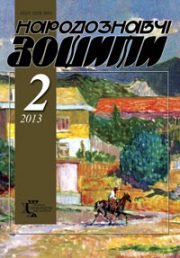The Ethnology Notebooks. 2023. № 4 (172), 1111—1120
UDK 801.81 (477.82) “1940/1960”
DOI https://doi.org/10.15407/nz2023.04.1111
DEMEDYUK Мaryna
- ORCID ID: https://orcid.org/0000-0003-4415-002X
- Candidate of Philology Sciences (= Ph.D. in Philology),
- Senior Researcher at the Institute of Ethnology
- of the National Academy of Sciences of Ukraine,
- Department of Folkloristics,
- 15, Svobody Avenue, 79000, Lviv, Ukraine,
- Contacts: e-mail: mdemedyuk@gmail.com; tel.: 0976105957
Abstract. Folklore narratives from Volyn Polissia are explored through the prism of P. Nora’s conceptoin of memorial spaces («lieux de mйmoire»). It was found that the memory of the World War II underwent transformations under the influence of historical features (Soviet occupation, restoration of independence of Ukraine, Russian-Ukrainian war).
The method of the proposed investigation is the study of the specificity and transformation of «lieux de mйmoire» in the oral traditional prose of Volyn Polissia.
Folklore narratives recorded by the author during her expeditions in 2018—2022 were chosen as the object of research.
The subject is a reflection in texts events related to the spaces of memory of the World War II.
The methodological basis of the work is the principles of objectivity and historicism of folklore, and the main methods are structural-typological, the method of conceptual analysis. The author also used the work experience of autobiographical narratives study in the world and Ukrainian scientific discourse.
The main blocks of plots are centered around a certain «lieux de mйmoire», the presence of which is possible for their reactualization. Thus, rebel graves-mounds (regardless of whether they were restored in the days of Independence or information about them is preserved only in the memory of storytellers) are important part of the space of modern villages and towns. Steles in memory of fallen UPA troops become modern «spaces of memory», which make it possible to talk about the fighters for Ukraine openly, to honor them on the occasion of certain holidays, and the names on the steles help to remember and in a certain way legitimize the narratives about the insurgent movement in Volyn Polissia. It turned out that the key events of the Second World War are etched in the memory in a significant way and because they are tied to a certain place.
The field becomes the place with which stories about the organization of the insurgent movement, training and gathering of insurgents are connected. In addition, the attempt of the Soviet authorities to give this space a new ideologically verified sound could not erase its original meaning associated with the struggle of the UPA.
Based on the analysis of the texts, it was found that in the minds of the narrators, a is identified with the entire stage of the struggle of the insurgents against the Nazi and Soviet occupations.
Keywords: folklore text, narratives, World War II, national liberation struggle, Volyn, place of memory.
Received 19.05.2023
REFERENCES
- Trigg, D. The Memory of Place: A Phenomenology of the Uncanny (Vol. 41) (Series In Continental Thought) Paperback. Retrieved from: https://www.academia.edu/355785/The_Memory_of_Place_a_Phenomenology_of_the_Uncanny_2012_ (Last accessed: 21.04.2023).
- Nora, P. (1989). Between memory and history. In Representations. Special Issue: Memory and Counter-Memory, 26, 7—24. Retrieved from: http://links.jstor.org/sici?sici=0734-6018%28198921%290%3A26%3C7%3ABMAHLL%3E2.0.CO%3B2-N (Last accessed: 21.04.2023).
- Judt, Т. (2004). «Places of Memory» by Pierre Nora: Whose places? Whose memory? Ab Imperio, 1, 44—71 [in Russian].
- Montano, E. (2008). Places of memory. Is the concept applicable to the analysis of memorial struggles? The case of Uruguay and its recent past. In Cuad. CLAEH (Vol. 4). Montevideo. Retrieved from: http://socialsciences.scielo.org/scielo.php?script=sci_arttext&pid=S0797-60622008000100001#_ftnref14 (Last accessed: 21.04.2023).
- Аssman, А. (2012). Spaces of memory. Forms and transformations of cultural memory. Kyiv [in Ukrainian].
- Horn, C., Wollentz, Di Maida, G., & Haug, A. (Ed.). (2000). Places of Memory. Spatialised practices of remembrance from prehistory to today. Oxford [in Ukrainian].
- Dovhopolova, О. Places of memory and our search for ourselves. In Verbum, 24. Retrieved from: verbum.com.ua/03/2019/memory-places/our-searching-for-the-self (Last accessed: 21.04.2023) [in Ukrainian].
- Reeves, К. (2018). Sites of memory: The Past in the Present History, Memory and Public Life (Pp. 65—79). Retrieved from: https://tandfbis.s3-us-west-2.amazonaws.com/rt-files/Docs/Sites+of+Memory+free+chapter.pdf (Last accessed: 21.04.2023).
- Nabok, S. (2017). Space and memory: at the crossroads of contexts. Scientific notes of the Institute of Political and Ethnonational Studies by I.F. Kuras of the National Academy of Sciences of Ukraine (Issue 5—6, pp. 244—253). Retrieved from: http://nbuv.gov. ua/UJRN/Nzipiend_2017_5—6_16 (Last accessed: 21.04.2023) [in Ukrainian].
- Winter, J., Radstone, S., & Schwarz, B. (Ed.). (2010). Sites of Memory. Memory. Histories, Theories, Debates. Fordham University Press (Pp. 312—324). Retrieved from: https://www.jstor.org/stable/j.ctt1c999bq.25 (Last accessed: 21.04.2023).
- Nahorna, L. (2014). The concept of «Memory location» in the system of memory studies. Regional history of Ukraine (Vol. 8, pp. 55—74). Retrieved from: http://nbuv.gov.ua/UJRN/reisuk_2014_8_5 (Last accessed: 21.04.2023) [in Ukrainian].
- Drohobytska, O. (2019). Commemoration of the heroes of national liberation struggles during the Green Holidays in Galicia (20s—30s of the 20th century). Galicia Scientific and cultural and educational local history magazine, 32, 175—185 [in Ukrainian].
- Kuzmenko, O. (2018). Dramatic existence of a human in Ukrainian folklore: conceptual forms of expression (the period of the First and Second World Wars). Lviv: Institute of Ethnology of the National Academy of Sciences of Ukraine [in Ukrainian].






